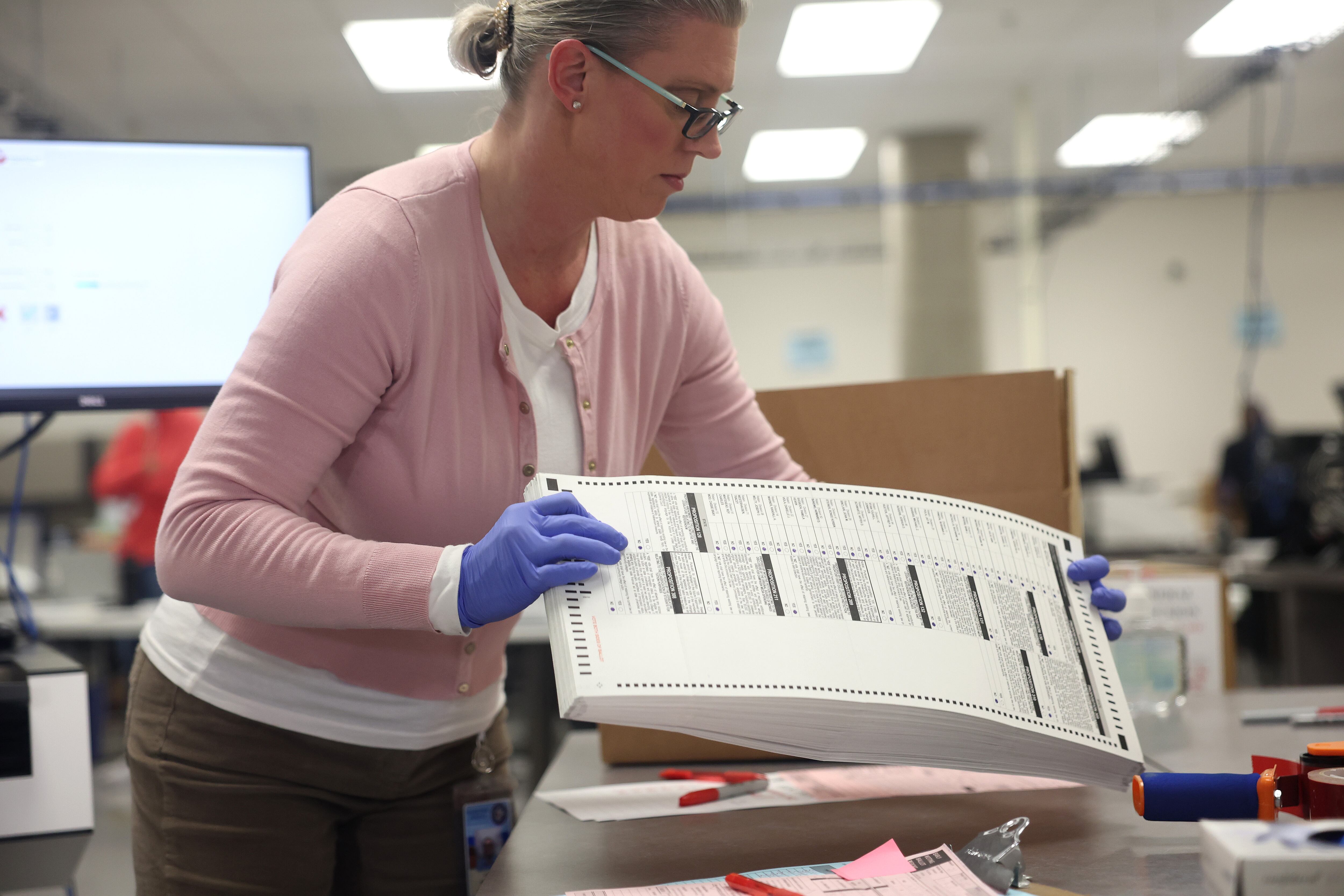This story has been updated throughout with details of a county budget meeting in January at which officials discussed the ballot printer problems.
Many of Maricopa County’s ballot printers were not able to handle the thickness and length of the county’s ballots, causing the printers’ failure across the county on Election Day, according to the results of an independent review released Monday.
“The combined effect of the heavy paper, longer ballot, and intermittent burst of print demand pushed the printers to perform at the very edge of or past their capability,” retired Arizona Supreme Court Justice Ruth McGregor, hired by the county to conduct the review, wrote in her report.
McGregor recommended that the county either replace some of its printers or make other changes, such as changing the ballot paper thickness or changing and increasing testing.
McGregor briefed the supervisors in an executive session Monday just prior to the report’s release. In an initial response to the report, County Supervisors Chairman Clint Hickman said the county should replace its equipment.
“We’ll make changes to best serve voters, starting with replacing some equipment,” he wrote in a news release.
County Elections Director Scott Jarrett had come to similar conclusions as McGregor by January, and put in a tentative budget request with the supervisors for $9 million dollars to buy 550 new, more robust printers to replace the faulty printers, according to a Jan. 25 budget presentation.
McGregor’s report comes five months after the Nov. 8 election, when voters saw widespread problems tabulating ballots at vote centers across the county. County officials repeatedly publicly stated that the printers the county uses to print ballots on demand weren’t printing the ballots darkly enough, the reason they couldn’t then be tabulated, but said they didn’t know why that didn’t occur during prior elections or pre-election testing. The nearly 17,000 ballots that could not be tabulated on-site were tabulated later at the county’s central elections center.
McGregor’s report detailing the problems confirmed much of what Votebeat found in an analysis published in December.
McGregor found that it was the factors combined for the first time — the county switching from 80 to 100-pound paper between the 2020 and 2022 elections, and then switching from 19 to 20 inch ballots between the 2022 primary and general elections — that caused the problems on Election Day. McGregor also found that the county’s testing was not robust enough to catch the problem, which didn’t show up during early voting because the county doesn’t tabulate ballots on-site during early voting.
While Republican gubernatorial candidate Kari Lake, who lost her election, claimed without proof in her election contest that county workers intentionally caused the problems tabulating ballots, McGregor wrote in her report that “nothing we learned in our interviews or document reviews gave any clear indication that the problems should have been anticipated.”
Lake and other GOP candidates who lost their elections claimed that the problems caused voter disenfranchisement, given the long lines generated in some places. McGregor emphasized that all ballots were counted, despite the problems.
While some have criticized Jarrett, who oversees Election Day voting, Hickman, a Republican, said McGregor’s report makes clear this was a partial equipment failure, and Jarrett was not at fault for not anticipating it.
“How can you blame [him]?” Hickman said. “I certainly don’t.”
McGregor declined to comment further on her report after the supervisors’ meeting on Monday. A spokesperson for the county attorney’s office said that the report “speaks for itself.”
What went wrong?
During the review, in February and March, McGregor and her team printed and tabulated 9,100 new ballots on randomly selected printers, interviewed 17 employees of the county and Runbeck Elections Systems, a vendor, and spoke with other election experts, according to the report.
The county uses two kinds of printers, Lexmark and OKI. The Lexmark printers are more robust and are used at voting locations with more demand.
McGregor’s team’s tests revealed that the fusers on some OKI printers, which heat up to melt toner onto the paper, could not maintain an adequate temperature when printing ballots. The thickness of the paper caused the fuser heat to dissipate more quickly, McGregor wrote, and the longer ballot made the effect more pronounced. Some printers handled the paper better than others, according to county and testing data.
Votebeat’s analysis in December found that the county used thicker ballot paper than the printer supports when printing on both sides of the page, according to the user manual for the OKI B432dn LED printers. Paper weight of up to 80 pounds is supported, but the county’s ballots were printed on 100-pound paper.
But Hickman said Monday that the spec sheet given to the county indicated that the printer would be able to handle the county’s ballots. He said that it may have been beneficial for the county to conduct more robust testing when changing so many factors prior to a large election.
On Election Day, the county announced partway through the day that it had discovered a “fix” by changing a setting that controlled how darkly the ballot envelopes and receipts were printing.
McGregor found in testing that the setting change reduced the number of ballots printed too faintly, “but in no instance did either change eliminate the problem.” Reports continued to come in of printers not operating correctly after the setting change was made, she found.
McGregor wrote that the primary cause of the Election Day failures was equipment failure, not a failure on the part of county employees. She also wrote that OKI had assured the county that the printers could be used for the job, but Hickman did not have details to share about that point on Monday.
“Despite the assurances of the manufacturer, many of the Oki B432 printers were not capable of reliably printing 20-inch ballots on 100-pound paper under Election-Day conditions,” the report stated.
McGregor: Replace printers, improve testing
The 2020 election was the first election in which the county used the OKI printers to tabulate ballots on-site on Election Day, after previously using them only to print ballot envelopes. The county retrofitted them for this purpose.
In 2020, the county used 80-pound paper, thinner than what it had used before. At the same time, the county began recommending using Sharpies to fill out ballots, adopting a recommendation from Dominion, because of their fast-drying properties.
That’s part of what caused what’s now known as “Sharpiegate.” The Sharpies bled through the thinner paper at times, causing voters to worry that their selections would not be read properly. Bleed-through doesn’t matter, though, because the ovals on the back are offset from the ones on the front.
Because of the Sharpie controversy, in 2022, county officials switched back to the 100-pound paper. For the general election, the county was required to increase the length of the paper to 20 inches, the longest in county history, because of the number of contests that had to be included on the ballot.
One of McGregor’s recommendations was to replace the OKI printers with more robust printers, which she believes would “eliminate or substantially reduce the printer issues seen during the general election.”
“During our tests, the Lexmark printers used during the general election successfully printed the 20-inch ballots on 100-pound paper without requiring any adjustment to the printer warehouse settings,” she wrote.
Jarrett said in January that his requested $9 million would pay for 550 new Lexmark printers of the same model. That’s about $16,400 for each printer. The county is planning to increase the number of vote centers from 223 to 250, and planning to have three Lexmark printers at each of the larger locations, Jarrett said.
The supervisors said at the time that they would revisit this request after receiving McGregor’s review. The supervisors are scheduled to approve a tentative budget on May 22 and finalize it on June 26.
The county could also go back to 80 pound paper, McGregor wrote, although that might again lead to the bleed-through on the ballot that alarmed some voters.
McGregor found that nothing in the OKI printers’ past performance or pre-election stress testing “indicated that such a failure was likely.”
Still, she recommended more extensive testing in the future.
To test the printers prior to the election, the county randomly selected four OKI and four Lexmark printers. Officials printed 100 double-sided ballots and scanned them through each test machine. As a second test, the county also printed 100 ballot envelopes and ballot receipts.
In that test, the ballots printed by the OKI printers showed speckling at the edge of the ballots, but the printing of the ballot was clear and the tabulating machines still scanned them.
When the county tested the printers, they tested them without any pause between batches of ballots. When ballots are printed at vote centers, they are printed for each individual voter and therefore there are pauses in printing. That means the fuser has to heat up each time, putting more stress on the printer.
McGregor recommended increasing the number of printers tested, scanning the test ballots with the same tabulators used at vote centers, and testing with pauses in between print batches to “more fairly represent election day conditions.”
McGregor paid $415 an hour, hired team
Immediately after Election Day, county election officials began an internal investigation into the problems. The county has not yet released the results of this internal review, even though Jarrett in January presented his conclusions from the review. He said at the time that the county identified five main factors that contributed to the problems: The ballot thickness, ballot length, intermittent printing, using Oki printers, and tabulating on-site.
Votebeat requested the internal report months ago and was told it was not yet complete. County officials did not immediately respond to another request for the internal report on Monday.
Former Supervisors Chairman Bill Gates said in February that he felt it was important to have “fresh eyes,” on the problems. Plus, an independent investigation is more likely to be trusted by those who don’t trust the county, he said at the time.
County Attorney Rachel Mitchell, with the support of the county supervisors, hired McGregor on Jan. 1 to conduct the independent review. McGregor brought on two election technology experts, the owner of a printer supply shop, and a lawyer.
Mitchell asked McGregor to answer at least three questions:
- What caused the printer problems?
- Why did these problems occur on Nov. 8 and not on the day of the primary election, Aug. 3?
- What steps can the county take to prevent these problems in the future?
McGregor hired four people to work for her. Votebeat reported last month that the county paid McGregor $415 an hour, and three others were paid between $125 to $250 an hour. The fourth person on McGregor’s team was just announced on Monday, and her salary has not yet been released. The County Attorney’s Office has not yet responded to a request for the total cost of the investigation.
On Election Day, the county sent technicians to around one-third of its 223 vote centers to deal with problems tabulating ballots, according to a letter county officials sent to the attorney general’s office in late November.
Jarrett said publicly in November and December that a few other problems, besides the toner glitch, caused some of the 17,000 misreads. For example, some printers were accidentally set to shrink the ballot image on the page, causing the ballot image to print at a too-small size and the tabulator to reject the ballot.
McGregor did not find that to be a major source of the Election Day problems during her tests. McGregor found this problem occurring randomly and sporadically during her tests.
“During our testing, four printers randomly printed one or a few ‘fit to page’ ballots in the middle of printing a batch of ballots. None of the technical people with whom we spoke could explain how or why that error occurred,” McGregor wrote.
Jen Fifield is a reporter for Votebeat based in Arizona. Contact Jen at jfifield@votebeat.org.






